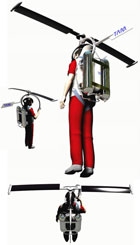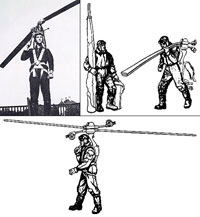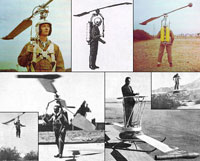The world's lightest helicopter
Mexican Aerospacial Tecnologia Mexicana (TAM), Mexico, has designed a small helicopter named Libelula, which experts call "Rocket Helicopter".

Libelula on design sketches
Every movement of this machine is thanks to a rocket engine mounted on the rear body. Designers say Libelula is the most perfect, most convenient means of comparison with similar devices ever produced. Because Libelula does not need a large tail, there is no need for two engines to support the usual rotation.
Furthermore, if the traditional single-seat helicopter is very heavy, the Libelula is lightweight, portable, can use any ground to operate. It can quickly bring people to the sky and this is what military experts have long dreamed of: Quick combat with parachute forces.
In fact, the invention above is nothing new. During the 20th century, many companies and many scientists designed and produced many types of personal helicopters (single seat). Austrian engineer Paul Baumgartl was the first to think of a helicopter - rocket.

Heliofly design by Paul Baumgartl in 1941 - 1943

MEG models from Evgheni Glukharev
Even in the years 1941 - 1943, he designed some of these helicopters under the common name Heliofly. However Heliofly did not apply successfully when it was quite heavy and because of the short-circuited engine, it was not strong enough.
By 1952, Evgheni Glukharev, Russian-American created MEG-1X helicopter, for the first time using a rocket engine to lift people to the sky. This type of vehicle is collectively known as Tip jet. MEG-1X weighs 104 kg, only one pinwheel (propeller) and balances thanks to a horizontal bar mounted on the bottom of the machine.
The fuel tank is mounted like a backpack on the back of the person flying. The MEG-1X engine weighs 90 kg and operates under compressed air mode, which makes this vehicle move at the highest speed of 90 km / h and the ceiling is 1.5 km. However, the operating time of MEG-1X only lasts 18 minutes. Later E.Glukharev built more MEG-2X, MEG-3X (1960), but the dissemination of this type of helicopter was not successful.
With TAM and its leader Juan Manuel Lozano, since 1975 they have studied the engine and similar techniques. Lozano later collaborated with Sentry Technology Group - specializing in small unmanned helicopter manufacturing projects - and some other experienced engineers successfully designed high-capacity jacks. 5-10 times more than the previous type. Learning from the previous failures of other firms, TAM not only designed helicopters but also full suit equipment.
Although currently only on the blueprint, Lozano claims Libelula will be the lightest, lightest helicopter ever. Because it will apply the most advanced techniques and technologies. This type of helicopter not only works well in the military field, but also in the rescue. Or simply, in Vietnam it can be a means to effectively prevent traffic jam in big cities!
- Russia tests unmanned aerial cum-shot helicopter
- Video: How to make a helicopter so simple
- Discover the lightest galaxy
- Helicopters run by human power
- The world's lightest dessert with 96% air, the rest weighing only 1 gram
- Transfiguration car
- The lightest electric skis in the world
- China launches unmanned helicopters can stealth
- Hippopotamus rushed out of the water to grab a helicopter
- NASA introduced a space helicopter with a helicopter wing
- Inside the world's first attack helicopter
- Russia's super-terrorist helicopter
 Daily use inventions come from universities
Daily use inventions come from universities Special weight loss device helps prevent appetite
Special weight loss device helps prevent appetite 8 inventors were killed by their own inventions
8 inventors were killed by their own inventions Iran invented a motor car powered by water
Iran invented a motor car powered by water